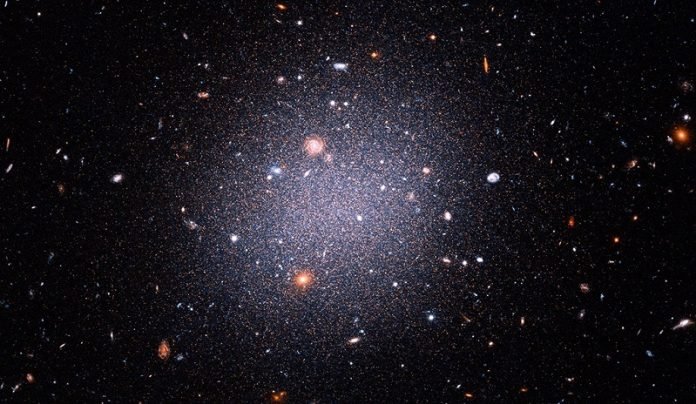
Three years ago, a team of astronomers led by Yale’s Pieter van Dokkum surprised the scientific community with the discovery of a far-off galaxy that contained little or no dark matter.
The discovery, made using NASA’s Hubble Space Telescope, had the potential to upend well-established theories about how galaxies form and evolve.
That is because dark matter — the invisible scaffolding that accounts for most of the universe’s mass — is considered essential for creating and shaping galaxies.
But how could a galaxy exist with almost no dark matter?
Some astronomers speculated the finding was incorrect. Specifically, they questioned the accuracy of distance measurements from Earth to NGC 1052-DF2 — the galaxy with no dark matter.
Now, in a new study published in The Astrophysical Journal Letters, van Dokkum and Yale graduate student Zili Shen have pinpointed the distance to DF2 and confirmed the earlier finding.
“We went out on a limb with our initial Hubble observations of this galaxy in 2018,” said van Dokkum, Yale’s Sol Goldman Family Professor of Astronomy.
“I think people were right to question it because it’s such an unusual result. It would be nice if there were a simple explanation, like a wrong distance. But I think it’s more fun and more interesting if it actually is a weird galaxy.”
Knowing the distance to DF2 is crucial to determining its dark matter content. The calculation of total mass is based on the motions of the stars within the galaxy; their velocities are influenced by the pull of gravity.
The researchers found that the observed stellar mass, which depends on distance, matches the galaxy’s overall mass, with minimal room left for dark matter.
However, if DF2 were closer to Earth, as some astronomers claim, it would be intrinsically fainter and less massive. The galaxy, therefore, would have more dark matter to account for the observed effects of the total mass.
In the original study, van Dokkum’s team estimated that DF2 was 65 million light-years away. Other scientific teams, working independently, put the distance at 42 million light-years away.
For their new distance measurement, van Dokkum and Shen used Hubble’s Advanced Camera for Surveys to grab long-exposure images of DF2.
They targeted aging, red giant stars on the outskirts of DF2 and used the stars’ brightness to calculate the distance from Earth.
“Studying the brightest red giants is a well-established distance indicator for nearby galaxies,” Shen said.
They determined the distance at 72 million light-years away, essentially confirming the initial finding.
“For almost every galaxy we look at, we say that we can’t see most of the mass because it’s dark matter. What you see is only the tip of the iceberg,” van Dokkum said. “But in this case, what you see is what you get. Hubble really shows the entire thing. That’s it. It’s not just the tip of the iceberg, it’s the whole iceberg.”
Yet the mystery of how a galaxy formed with almost no dark matter remains.
After van Dokkum’s original study in 2018, former Yale astronomer Shany Danieli, of the Institute for Advanced Study, found a second galaxy — NGC 1052-DF4 — that is also nearly devoid of dark matter.
Danieli is a co-author of the new study. In 2020, a separate research group found 19 dwarf galaxies that may be lacking in dark matter, as well.
“There’s a saying that extraordinary claims require extraordinary evidence, and the new distance measurement strongly supports our previous finding that DF2 is missing dark matter,” Shen said. “Now it’s time to move beyond the distance debate and focus on how such galaxies came to exist.”
Written by Jim Shelton.



